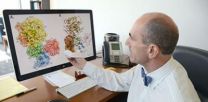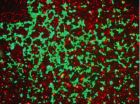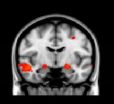(Press-News.org) A three-dimensional porous nanostructure would have a balance of strength, toughness and ability to transfer heat that could benefit nanoelectronics, gas storage and composite materials that perform multiple functions, according to engineers at Rice University.
The researchers made this prediction by using computer simulations to create a series of 3-D prototypes with boron nitride, a chemical compound made of boron and nitrogen atoms. Their findings were published online July 14 in the Journal of Physical Chemistry C.
The 3-D prototypes fuse one-dimensional boron nitride nanotubes and two-dimensional sheets of boron nitride.
"We combined the tubes and sheets together to make them three-dimensional, thus offering more functionality," said Rouzbeh Shahsavari, assistant professor of civil and environmental engineering and of materials science and nanoengineering, who co-authored the paper with graduate student Navid Sakhavand. In the 3-D nanostructure, the extremely thin sheets of boron nitride are stacked in parallel layers, with tube-shaped pillars of boron nitride between each layer to keep the sheets separated.
Shahsavari noted that in the one-dimensional and two-dimensional versions of boron nitride, there is always a bias in directional properties, either toward the tube axis or in-plane directions, which is not suitable for widespread 3-D use in technology and industrial applications.
For example, a one-dimensional boron nitride nanotube can be stretched about 20 percent of its length before it breaks, but the 3-D prototype of boron nitride can be stretched about 45 percent of its length without breaking.
When the typical one- or two-dimensional boron nitride materials are stretched in one direction, they tend to shrink in the other perpendicular directions. In the 3-D prototype, however, when the material stretches in the in-plane direction, it also stretches in perpendicular directions. "Here, the junction between the tubes and sheets has a unique curve-like structure that contributes to this interesting phenomenon, known as the auxetic effect," Shahsavari said.
The thermal transport properties of the 3-D prototype are also advantageous, he said. The one-dimensional boron nitride tubes and two-dimensional sheets can carry heat very fast but only in one or two directions. The 3-D prototype carries heat relatively fast in all 3-D directions. "This feature is ideal for applications that require materials or coating with the capability of extremely fast thermal diffusion to the environments. Examples include car engines or computer CPUs where a fast heat transfer to the environments is critical in proper functioning," Shahsavari said.
The 3-D boron nitride prototype has a very porous and lightweight structure. Each gram of this Swiss cheese-like structure has a surface area equivalent to three tennis courts. Such a high surface area lends itself to customized applications. Shahsavari and Sakhavand predicted that the 3-D prototype of boron nitride would allow efficient gas storage and separation, for example, in vehicles that run on hydrogen cells.
Unlike graphene-based nanostructures, boron nitride is an electrically insulating material. Thus, the 3-D boron nitride prototype has a potential to complement graphene-based nanoelectronics, including potential for the next generation of 3-D semiconductors and 3-D thermal transport devices that could be used in nanoscale calorimeters, microelectronic processes and macroscopic refrigerators.
The actual 3-D boron nitride prototype still has to be created in the lab, and numerous efforts are already underway. "Our computer simulations show what properties can be expected from these structures and what the key factors are that control their functionality," Shahsavari said.
INFORMATION:
The research was funded by Rice University. The supercomputers used for the research are supported by the National Institutes of Health, IBM, CISCO, Qlogic and Adaptive Computing and the Data Analysis and Visualization Cyber infrastructure funded by the National Science Foundation.
A high-resolution image is available for download at:
http://news.rice.edu/wp-content/uploads/2014/07/Shahsavari.jpg
A copy of the Journal of Physical Chemistry C paper is available at:
http://pubs.acs.org/doi/pdfplus/10.1021/jp5044706
Follow Rice News and Media Relations on Twitter @RiceUNews.
Located on a 300-acre forested campus in Houston, Rice University is consistently ranked among the nation's top 20 universities by U.S. News & World Report. Rice has highly respected schools of Architecture, Business, Continuing Studies, Engineering, Humanities, Music, Natural Sciences and Social Sciences and is home to the Baker Institute for Public Policy. With 3,920 undergraduates and 2,567 graduate students, Rice's undergraduate student-to-faculty ratio is just over 6-to-1. Its residential college system builds close-knit communities and lifelong friendships, just one reason why Rice has been ranked No. 1 for best quality of life multiple times by the Princeton Review and No. 2 for "best value" among private universities by Kiplinger's Personal Finance.
3-D nanostructure could benefit nanoelectronics, gas storage
Rice University researchers predict functional advantages of 3-D boron nitride
2014-07-15
ELSE PRESS RELEASES FROM THIS DATE:
TGen-led study finds likely origin of lung fungus invading Pacific Northwest
2014-07-15
FLAGSTAFF, Ariz. - Cryptococcus gattii, a virulent fungus that has invaded the Pacific Northwest is highly adaptive and warrants global "public health vigilance," according to a study by an international team led by the Translational Genomics Research Institute (TGen).
C. gattii, which likely originated in Brazil, is responsible for dozens of deaths in recent years since it was first found in 1999 on Vancouver Island, British Columbia, Canada, well outside its usual tropical habitats.
"We identified several genes that may make the outbreak strains more capable of surviving ...
Rice nanophotonics experts create powerful molecular sensor
2014-07-15
Nanophotonics experts at Rice University have created a unique sensor that amplifies the optical signature of molecules by about 100 billion times. Newly published tests found the device could accurately identify the composition and structure of individual molecules containing fewer than 20 atoms.
The new imaging method, which is described this week in the journal Nature Communications, uses a form of Raman spectroscopy in combination with an intricate but mass reproducible optical amplifier. Researchers at Rice's Laboratory for Nanophotonics (LANP) said the single-molecule ...
SLU scientists hit 'delete': Removing regions of shape-shifting protein explains how blood clots
2014-07-15
ST. LOUIS – In results recently published in Proceedings of the National Academy of Sciences (PNAS), Saint Louis University scientists have discovered that removal of disordered sections of a protein's structure reveals the molecular mechanism of a key reaction that initiates blood clotting.
Enrico Di Cera, M.D., chair of the Edward A. Doisy department of biochemistry and molecular biology at Saint Louis University, studies thrombin, a key vitamin K-dependent blood-clotting protein, and its inactive precursor prothrombin (or coagulation factor II).
"Prothrombin is essential ...
New skin gel fights breast cancer without blood clot risk
2014-07-15
CHICAGO --- A gel form of tamoxifen applied to the breasts of women with noninvasive breast cancer reduced the growth of cancer cells to the same degree as the drug taken in oral form but with fewer side effects that deter some women from taking it, according to new Northwestern Medicine® research.
Tamoxifen is an oral drug that is used for breast cancer prevention and as therapy for non-invasive breast cancer and invasive cancer.
Because the drug was absorbed through the skin directly into breast tissue, blood levels of the drug were much lower, thus, potentially ...
Game theory model reveals vulnerable moments for cancer cells' energy production
2014-07-15
Cancer's no game, but researchers at Johns Hopkins are borrowing ideas from evolutionary game theory to learn how cells cooperate within a tumor to gather energy. Their experiments, they say, could identify the ideal time to disrupt metastatic cancer cell cooperation and make a tumor more vulnerable to anti-cancer drugs.
"The reality is that we still can't cure metastatic cancer that has spread from its primary organ and game theory adds to our efforts to attack the problem," says Kenneth J. Pienta, M.D., the Donald S. Coffey Professor of Urology at the Johns Hopkins ...
Adolescent males seek intimacy and close relationships with the opposite sex
2014-07-15
July 15, 2014 -- Teenage boys desire intimacy and sex in the context of a meaningful relationship and value trust in their partnerships, according to researchers at Columbia University's Mailman School of Public Health. The research provides a snapshot of the development of masculine values in adolescence, an area that has been understudied. Findings are online in the American Journal of Men's Health.
The researchers studied 33 males who ranged from 14 to 16 years of age to learn more about how their romantic and sexual relationships developed, progressed, and ended. ...
Fish oil supplements reduce incidence of cognitive decline, may improve memory function
2014-07-15
PROVIDENCE, R.I. –Rhode Island Hospital researchers have completed a study that found regular use of fish oil supplements (FOS) was associated with a significant reduction in cognitive decline and brain atrophy in older adults. The study examined the relationship between FOS use during the Alzheimer's Disease Neuroimaging Initiative (ADNI) and indicators of cognitive decline. The findings are published online in advance of print in the journal Alzheimer's & Dementia.
"At least one person is diagnosed every minute with Alzheimer's disease (AD) and despite best efforts, ...
Brain responses to emotional images predict PTSD symptoms after Boston Marathon bombing
2014-07-15
The area of the brain that plays a primary role in emotional learning and the acquisition of fear – the amygdala – may hold the key to who is most vulnerable to post-traumatic stress disorder.
Researchers at the University of Washington, Boston Children's Hospital, Harvard Medical School and Boston University collaborated on a unique opportunity to study whether patterns of brain activity predict teenagers' response to a terrorist attack.
The team had already performed brain scans on Boston-area adolescents for a study on childhood trauma. Then in April 2013 two bombs ...
Study finds unintended consequences of raising state math, science graduation requirements
2014-07-15
WASHINGTON, D.C., July 15, 2014 ─ Raising state-mandated math and science course graduation requirements (CGRs) may increase high school dropout rates without a meaningful effect on college enrollment or degree attainment, according to new research published in Educational Researcher (ER), a peer-reviewed journal of the American Educational Research Association.
VIDEO: Co-authors Andrew D. Plunk and William F. Tate discuss key findings. https://www.youtube.com/watch?v=jwxh1gj-T1M&feature=youtu.be
"Intended and Unintended Effects of State-Mandated High School ...
BUSM study: Obesity may be impacted by stress
2014-07-15
Using experimental models, researchers at Boston University School of Medicine (BUSM) showed that adenosine, a metabolite released when the body is under stress or during an inflammatory response, stops the process of adipogenesis, when adipose (fat) stem cells differentiate into adult fat cells.
Previous studies have indicated adipogenesis plays a central role in maintaining healthy fat homeostasis by properly storing fat within cells so that it does not accumulate at high levels in the bloodstream. The current findings indicate that the body's response to stress, potentially ...
LAST 30 PRESS RELEASES:
Numbers in our sights affect how we perceive space
SIMJ announces global collaborative book project in commemoration of its 75th anniversary
Air pollution exposure and birth weight
Obstructive sleep apnea risk and mental health conditions among older adults
How talking slows eye movements behind the wheel
The Ceramic Society of Japan’s Oxoate Ceramics Research Association launches new international book project
Heart-brain connection: international study reveals the role of the vagus nerve in keeping the heart young
Researchers identify Rb1 as a predictive biomarker for a new therapeutic strategy in some breast cancers
Survey reveals ethical gaps slowing AI adoption in pediatric surgery
Stimulant ADHD medications work differently than thought
AI overestimates how smart people are, according to HSE economists
HSE researchers create genome-wide map of quadruplexes
Scientists boost cell "powerhouses" to burn more calories
Automatic label checking: The missing step in making reliable medical AI
Low daily alcohol intake linked to 50% heightened mouth cancer risk in India
American Meteorological Society announces Rick Spinrad as 2026 President-Elect
Biomass-based carbon capture spotlighted in newly released global climate webinar recording
Illuminating invisible nano pollutants: advanced bioimaging tracks the full journey of emerging nanoscale contaminants in living systems
How does age affect recovery from spinal cord injury?
Novel AI tool offers prognosis for patients with head and neck cancer
Fathers’ microplastic exposure tied to their children’s metabolic problems
Research validates laboratory model for studying high-grade serous ovarian cancer
SIR 2026 delivers transformative breakthroughs in minimally invasive medicine to improve patient care
Stem Cell Reports most downloaded papers of 2025 highlight the breadth and impact of stem cell research
Oxford-led study estimates NHS spends around 3% of its primary and secondary care budget on the health impacts of heat and cold in England
A researcher’s long quest leads to a smart composite breakthrough
Urban wild bees act as “microbial sensors” of city health.
New study finds where you live affects recovery after a hip fracture
Forecasting the impact of fully automated vehicle adoption on US road traffic injuries
Alcohol-related hospitalizations from 2016 to 2022
[Press-News.org] 3-D nanostructure could benefit nanoelectronics, gas storageRice University researchers predict functional advantages of 3-D boron nitride


